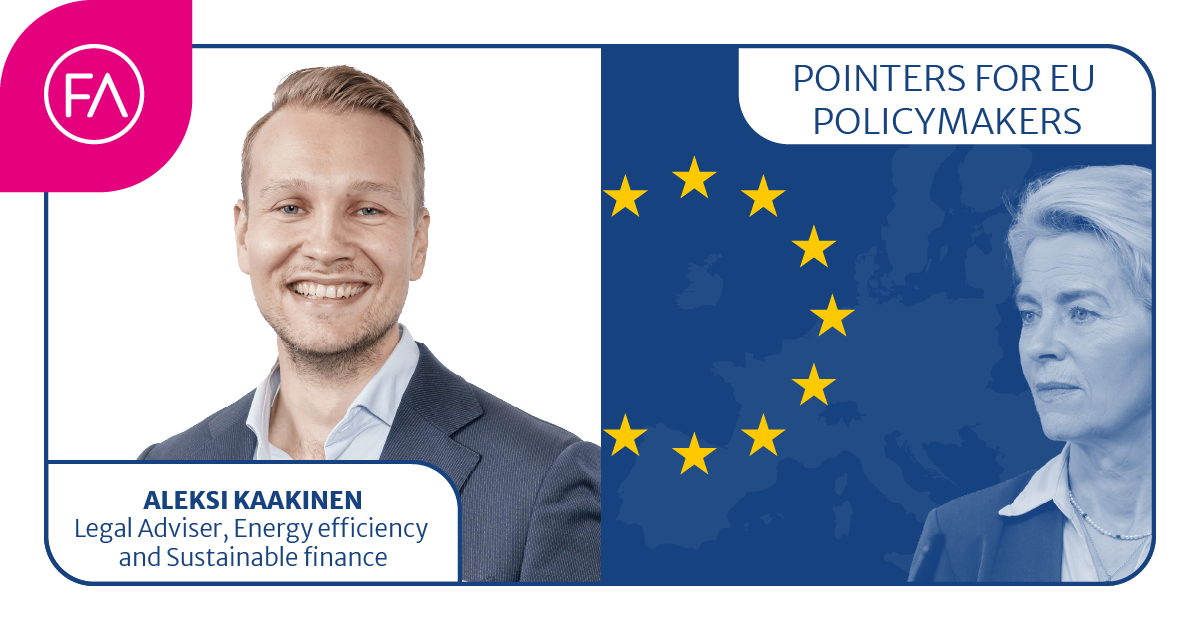
Key goals of the EU’s 2024–2029 strategic agenda include bolstering the EU’s competitiveness and making a success of the green and digital transitions. These goals are mutually supportive.
In the previous EU term, one of the priorities was the European Green Deal. In her political guidelines for the new term, European Commission President Ursula von der Leyen introduced a new Clean Industrial Deal. Its goal is to support and create the right conditions for companies to carry out the green transition.
In practice, this means things like ensuring easy access to affordable and sustainable energy supplies and raw materials and lightening the regulatory burden of especially small and medium-sized enterprises.
These goals are ambitious and highly welcome. But in the same breath I must point out that the new Commission must not cast aside the previous Commission’s works, some of which currently stand on precariously wobbly feet.
======
The financial sector is proud to
step up to the challenge and lead the way.
======
Recent years have seen the introduction of a lot of new sustainable finance regulation, targeted especially at the financial sector. The point of this is to channel finance to companies and projects that promote the achievement of climate and environment goals and thus support the greening of the economy. The financial sector is proud to step up to the challenge and lead the way.
Over the past five years, our member organisations have invested in the green transition, established green funds and issued green bonds. Our members are signatories to various commitments and programmes whose aim is to increase awareness of the importance of sustainability in the financial sector. This is the only possible way forward.
Regulation, however, poses some problems. Throughout the 2020s, Finance Finland and our European sister organisations have been calling attention to the excessively fast processing pace, extensive volume and ambiguous content that sustainable finance regulation suffers from.
======
The European sustainable finance framework
has been set up at an alarmingly fast pace.
======
Numerous regulations have been enacted on a tight schedule, including the EU Taxonomy for sustainable activities and the EU Sustainable Finance Disclosures Regulation (SFDR) to name but a few. The pace at which the European sustainable finance framework has been set up is alarmingly fast.
While the objective of the framework is supportable, the same cannot always be said for the outcome. Adopted in quick succession, the regulations are partially overlapping, which further complicates the situation.
For example, both the Taxonomy Regulation and the SFDR include a definition of sustainable investment, but despite the shared goals of these regulations, their definitions are not consistent with one another. For a financial sector company to be able to prepare a Taxonomy report, it needs to give an extensive account of its value chains and related activities. This can pose serious problems, especially if there are gaps in the data required for the reporting.
Financial sector companies will be subject to sustainability reporting obligations under the Corporate Sustainability Reporting Directive (CSRD) from financial year 2025. They must assess their own and their stakeholders’ performance based on over 800 data points. This work is not made any easier by phrasings that are complicated and open to interpretation or by gaps in data.
======
The fear is that excessive data requirements will
reduce sustainability reporting to a mere exercise,
torpedoing the intended outcome.
======
The fear is that excessive data requirements will reduce sustainability reporting to a mere exercise, torpedoing the intended outcome: a concise info pack that would give consumers the information they need to make well-founded decisions.
For the green transition to be successful, it must be backed up by European legislation that is uniform, easy to interpret and economically feasible. Finance Finland hopes that the new Commissioners will turn their attention to where the previous Commissioners also set their eyes on: financing transitioning companies.
The green transition cannot be carried out if we only finance companies that are already green. We need concrete tools for companies that want to make the transition but lack the means. We must also critically examine existing regulation and its functionality, trim any excesses and improve the feasibility of regulation.
Von der Leyen’s previously stated goal of reducing reporting requirements by 25% would ideally target the excess and overlap in sustainable finance regulation that does not genuinely promote the green transition. The goal must be for regulation to help consumers make more sustainable choices.
Still have questions?
|Contact the columnist
Looking for more?
Other articles on the topic

Clear and uniform sustainable finance regulation enhances the EU’s competitiveness

The EU Sustainable Finance Disclosures Regulation has promise but lacks in execution

Will the wild west of ESG ratings soon be history? – New regulation facilitates the assessment of sustainability factors

The financial sector has power to halt biodiversity loss – International experts presented their measures in Helsinki




